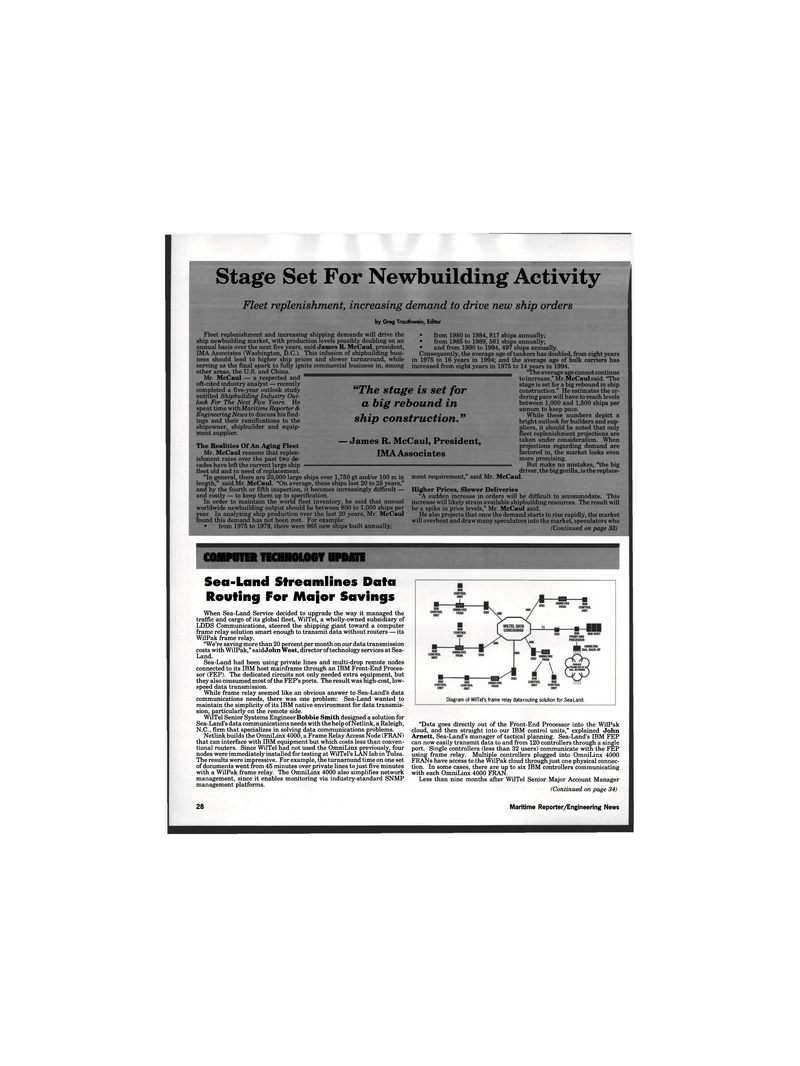
Page 26: of Maritime Reporter Magazine (June 1995)
Read this page in Pdf, Flash or Html5 edition of June 1995 Maritime Reporter Magazine
Stage Set For Newbuilding Activity
Fleet replenishment, increasing demand to drive new ship orders by Greg Trauthwein, Editor
Fleet replenishment and increasing shipping demands will drive the ship newbuilding market, with production levels possibly doubling on an annual basis over the next five years, said James R. McCaul, president,
IMA Associates (Washington, D.C.). This infusion of shipbuilding busi- ness should lead to higher ship prices and slower turnaround, while serving as the final spark to fully ignite commercial business in, among other areas, the U.S. and China.
Mr. McCaul — a respected and oft-cited industry analyst — recently completed a five-year outlook study entitled Shipbuilding Industry Out- look For The Next Five Years. He spent time with Maritime Reporter &
Engineering News to discuss his find- ings and their ramifications to the shipowner, shipbuilder and equip- ment supplier.
Ui
The Realities Of An Aging Fleet
Mr. McCaul reasons that replen- ishment rates over the past two de- cades have left the current large ship ^————-——^ fleet old and in need of replacement. "In general, there are 20,000 large ships over 1,750 gt and/or 100 m in length," said Mr. McCaul. "On average, these ships last 20 to 25 years," and by the fourth or fifth inspection, it becomes increasingly difficult — and costly — to keep them up to specification.
In order to maintain the world fleet inventory, he said that annual worldwide newbuilding output should be between 800 to 1,000 ships per year. In analyzing ship production over the last 20 years, Mr. McCaul found this demand has not been met. For example: • from 1975 to 1979, there were 965 new ships built annually; • from 1980 to 1984, 817 ships annually; • from 1985 to 1989, 561 ships annually; • and from 1990 to 1994, 497 ships annually.
Consequently, the average age of tankers has doubled, from eight years in 1975 to 16 years in 1994; and the average age of bulk carriers has increased from eight years in 1975 to 14 years in 1994. "The average age cannot continue to increase," Mr.McCaul said. "The stage is set for a big rebound in ship construction." He estimates the or- dering pace will have to reach levels between 1,000 and 1,500 ships per annum to keep pace.
While these numbers depict a bright outlook for builders and sup-g liers, it should be noted that only eet replenishment projections are taken under consideration. When projections regarding demand are factored in, the market looks even more promising.
But make no mistakes, "the big driver, the big gorilla, is the replace-
The stage is set for a big rebound in ship construction." — James R. McCaul, President,
IMA Associates ment requirement," said Mr. McCaul.
Higher Prices, Slower Deliveries "A sudden increase in orders will be difficult to accommodate. This increase will likely strain available shipbuilding resources. The result will be a spike in price levels," Mr. McCaul said.
He also projects that once the demand starts to rise rapidly, the market will overheat and draw many speculators into the market, speculators who (Continued on page 33)
COMPUTER TECHNOLOGY UPDATE
Sea-Land Streamlines Data
Routing For Major Savings
Diagram of WilTel's frame relay data-routing solution for Sea-Land.
When Sea-Land Service decided to upgrade the way it managed the traffic and cargo of its global fleet, WilTel, a wholly-owned subsidiary of
LDDS Communications, steered the shipping giant toward a computer frame relay solution smart enough to transmit data without routers — its
WilPak frame relay. "We're saving more than 20 percent per month on our data transmission costs with WilPak," said John West, director of technology services at Sea-
Land.
Sea-Land had been using private lines and multi-drop remote nodes connected to its IBM host mainframe through an IBM Front-End Proces- sor (FEP). The dedicated circuits not only needed extra equipment, but they also consumed most of the FEP's ports. The result was high-cost, low- speed data transmission.
While frame relay seemed like an obvious answer to Sea-Land's data communications needs, there was one problem: Sea-Land wanted to maintain the simplicity of its IBM native environment for data transmis- sion, particularly on the remote side.
WilTel Senior Systems Engineer Bobbie Smith designed a solution for
Sea-Land's data communications needs with the help of Netlink, a Raleigh,
N.C., firm that specializes in solving data communications problems.
Netlink builds the OmniLinx 4000, a Frame Relay Access Node (FRAN) that can interface with IBM equipment but which costs less than conven- tional routers. Since WilTel had not used the OmniLinx previously, four nodes were immediately installed for testing at WilTel's LAN lab in Tulsa.
The results were impressive. For example, the turnaround time on one set of documents went from 45 minutes over private lines to just five minutes with a WilPak frame relay. The OmniLinx 4000 also simplifies network management, since it enables monitoring via industry-standard SNMP management platforms. "Data goes directly out of the Front-End Processor into the WilPak cloud, and then straight into our IBM control units," explained John
Arnett, Sea-Land's manager of tactical planning. Sea-Land's IBM FEP can now easily transmit data to and from 120 controllers through a single port. Single controllers (less than 32 users) communicate with the FEP using frame relay. Multiple controllers plugged into OmniLinx 4000
FRANs have access to the WilPak cloud through just one physical connec- tion. In some cases, there are up to six IBM controllers communicating with each OmniLinx 4000 FRAN.
Less than nine months after WilTel Senior Major Account Manager (Continued on page 34) 28 Maritime Reporter/Engineering News

 25
25

 27
27
